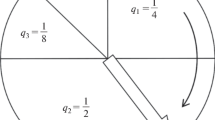Abstract
We propose the general framework of a new algorithm, derived from the interactions of chains of RNA, which is capable of self-organization. It considers sequences of binary numbers (strings) and their interaction with each other. Analogous to RNA systems, a folding of sequences is introduced to generate alternative two-dimensional forms of the binary sequences. The two-dimensional forms of strings can naturally interact with one-dimensional forms and generate new sequences. These new sequences compete with the original strings due to selection pressure. Populations of initially random strings develop in a stochastic reaction system, following the reaction channels between string types. In particular, replicating and self-replicating string types can be observed in such systems.
Similar content being viewed by others
References
Banzhaf W (1990a) The “molecular” travelling salesman. Biol Cybern 64:7–14
Banzhaf W (1990b) Finding the global minimum of a low-dimensional spin-glass model. In: Voigt HM, Mühlenbein H, Schwefel HP (eds) Selected papers on evolution theory, combinatorial optimization and related topics Academie, Berlin
Banzhaf W (1993a) Self-replicating sequences of binary numbers. Foundations II: Strings of length N = 4. Biol Cybern 69:275–281
Banzhaf W (1993b) Self-replicating sequences of binary numbers. Foundations III: Larger systems. Biol Cybern (submitted)
Bryngelson J, Wolynes P (1987) Spin glasses and the statistical mechanics of protein folding. Proc Natl Acad Sci USA 84:7524–7528
Chaitin GJ (1987) Algorithmic information theory. Cambridge University Press, Cambridge, UK
Dewdney AK (1985) Computer recreations. Sci Am 257(3): 21–32
Eigen M (1971) Self-organisation of matter and the evolution of biological molecules. Naturwissenschaften 58:465–523
Fontana W (1991) Algorithmic chemistry. In: Langton CG, Taylor C, Farmer JD, Rasmussen S (eds) Artificial life 2. Addison-Wesley, Redwood City, Calif
Fontana W, Schuster P (1987) A computer model of evolutionary optimization. Biophys Chem 26:123–147
Fontana W, Schnabl W, Schuster P (1989) Physical aspects of evolutionary optimization and adaptation. Phys Rev A40:3301–3321
Goldberg D (1989) Genetic algorithms in search, optimization and machine learning. Addison-Wesley, Reading, Mass
Guerrier-Takada C, Gardiner K, Marsh T, Pace N, Altman S (1983) The RNA moiety of ribonuclease P is the catalytic subunit of the enzyme. Cell 35:849–857
Haken H (1983) Synergetics. An Introduction. Springer, Berlin
Holland JH (1975) Adaption in natural and artificial systems. University of Michigan Press, Ann Arbor
Kauffman S (1986) Autocatalytic sets of proteins. J Theor Biol 119:1–24
Kruger K, Grabowski PJ, Zaug AJ, Sands J, Gottschling DE, Cech TR (1982) Self-splicing RNA: autoexcision and autocyclization of the ribosomal RNA intervening sequence of Tetrahymena. Cell 31:147–157
Lau KF, Dill KA (1989) A lattice statistical mechanics model of the conformational and sequence spaces of proteins. Macromolecules 22:3986–3997
Lewin B (1987) Genes, 3rd edn. Wiley, New York
Li Z, Scheraga H (1987) Monte Carlo-minimization approach to the multiple-minima problem in protein folding. Proc Natl Acad Sci USA 84:6611–6615
Quian N, Sejnowski T (1988) Predicting the secondary structure of globular proteins using neural network models. J Mol Biol 202:865–884
Rechenberg I (1973) Evolutionsstrategien. Frommann-Holzboog, Stuttgart
Robson B, Garnier J (1986) Introduction to proteins and protein engineering. Elsevier, Amsterdam
Schwefel HP (1981) Numerical optimization of computer models. Wiley, Chichester
Wang Q (1987) Optimization by simulating molecular evolution. Biol Cybern 57:95–101
Author information
Authors and Affiliations
Additional information
Dedicated to Professor Hermann Haken on the occasion of this 65th birthday
Rights and permissions
About this article
Cite this article
Banzhaf, W. Self-replicating sequences of binary numbers. Foundations I: General. Biol. Cybern. 69, 269–274 (1993). https://doi.org/10.1007/BF00203123
Received:
Accepted:
Issue Date:
DOI: https://doi.org/10.1007/BF00203123




